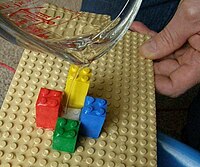Water retention on mathematical surfaces

Imagine you have a paper towel and you pour some water on top of it. The water will spread out and cover the entire towel. But if you fold the towel in half, the water will be trapped between the layers of the towel and won't be able to spread out anymore.
Now imagine instead of a paper towel, we have a mathematical surface (which is just a fancy way of saying a surface that can be described using math). Some mathematical surfaces are curved or have valleys or bumps, just like a paper towel can be folded to create little pockets. When water is poured onto these surfaces, it can get trapped in these pockets and create what is called "water retention."
That's basically what water retention on mathematical surfaces is. It's when water gets trapped or held in place on the surface because of its shape or structure. Scientists and mathematicians study this phenomenon to better understand how liquids behave on different surfaces, and how to design surfaces that can hold or repel liquids in useful ways.
Now imagine instead of a paper towel, we have a mathematical surface (which is just a fancy way of saying a surface that can be described using math). Some mathematical surfaces are curved or have valleys or bumps, just like a paper towel can be folded to create little pockets. When water is poured onto these surfaces, it can get trapped in these pockets and create what is called "water retention."
That's basically what water retention on mathematical surfaces is. It's when water gets trapped or held in place on the surface because of its shape or structure. Scientists and mathematicians study this phenomenon to better understand how liquids behave on different surfaces, and how to design surfaces that can hold or repel liquids in useful ways.
Related topics others have asked about:
